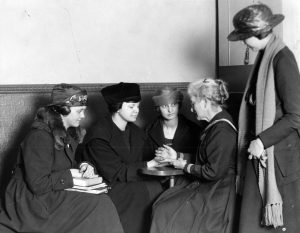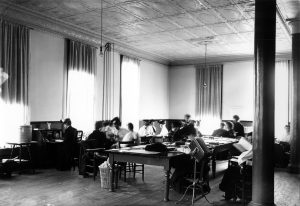Written by Sarah Stouffer-Lerch
The first women attending Ohio State University did not have guaranteed student housing or a centralized meeting place—luxuries that were often afforded to their male counterparts. Instead, they would need to find the rare rooming house that would grant them boarding or, for those with family nearby, live at home. For those who were able to find lodging, the ability to socialize with other women was limited both because of the lack of a women’s dorm. In addition, Neil Farm, the property on which Ohio State University originally existed, found itself isolated from the main parts of Columbus at the time.
Early faculty member Norton Townshend—father of Harriet and Alice, the first two women students at Ohio State University—decided to address the unmet need for a space for women on campus. His office became the first iteration of what became known as the Gab Room, a derogatory name which labeled a designated area for the socialization of women students. Despite the name, University women saw the office as much more than just a physical space. Although the location changed several times as Ohio State grew, the Gab Room remained constant as both a social hang-out spot and, in some regards, a war room for women students to advocate for their equality on campus.
A prime example of advocation in the Gab Room occurred in 1882 when the university’s forty-five women students congregated to sign a petition to the Board of Trustees. They wanted a women’s dormitory, supplying proper room and board for the growing body of women students. Although then-University president Walter Quincy Scott supported the endeavor, the request was denied.
In 1890, the location of the Gab Room moved to Hayes Hall. No University funds were given in order to furnish the room, so the women did their own fundraising. When a water pipe burst in 1892, the women of the Gab Room once again petitioned the university—their pleas were heard and he water issue was quickly resolved.
One of the last major functions the Gab Room served was as a rallying point for the Women’s Self-Governing Association (WGSA). In the 1920s, the WGSA found itself fighting for a Women’s Union Building. The WGSA members would invite legislators to the Gab Room, now located on the second floor of University Hall. Before the legislators arrived, the spot was made to look even shabbier than its normal appearance. This campaign continued until 1927 when Pomerene Hall, the university’s Center of Women’s Activities, was built. Ostensibly, Pomerene Hall made the Gab Room redundant, ultimately finding itself cleared for other purposes in the early 1930s.







Recent Comments